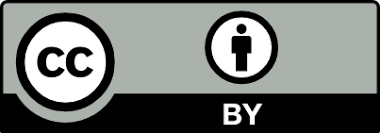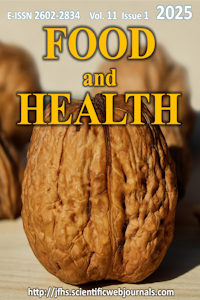Development and validation of gas chromatography-mass spectrometry method for the detection of zearalenone and its metabolites in cereal-based infant formulas
Abstract
Food safety is a high priority for human health. Chemical substances contaminated at different stages can cause acute and chronic health problems. Infants are one of the essential risk groups. Studies on endocrine disruptors are particularly important as these substances have many undesirable consequences for future generations, notably their impact on the reproductive system. Zearalenone (ZON), produced by Fusarium fungi, is an endocrine-disrupting mycotoxin with an estrogenic effect. Many species of fungi are localised on agricultural products such as corn, rice, and wheat. Feeding infants in the early stages of life with plant-based formula may lead to harmful effects of mycotoxins. We aimed to investigate whether commercially available cereal-based infant formulas are contaminated with ZON. Gas Chromatography – Mass Spectrometry (GC-MS) was used to determine ZON and metabolites. The method was developed by optimisation studies in sample preparation. The process was accurate, selective, reproducible, and highly sensitive at concentrations below the maximum residue level. ZON was validated using two different working ranges (for 1st working range: 0, 5, 10, 20, 30 ng/g; r2 are 0.993, 0.995; 1.08 ng/g, LODs are 1.08, 1.01 and 1.2 ng/g; LOQs are 3.25, 3.01 and 3.62 ng/g, and 2nd working ranges: 0, 1, 2, 3, 4 ng/g; r2 are 0.996, 0.994, and 0.996; LODs are 0.20, 0.200 ng/g, 0.06 g/ng; LOQs are 0.18, 0.60 ng/g and 0.60 g/ng for ZON, α-ZOL and β-ZOL, respectively). Cereal-based infant formulas sold retail in the market were not contaminated with ZON and its metabolites. Infants consuming these products are not at risk from cereal-based formulas.
Ethical Statement
The authors declare that this study does not include experiments with human or animal subjects, so ethics committee approval is not required.
References
- Apffel, A., Zhao, L., Sartain, M.J. (2021). A Novel Solid Phase Extraction Sample Preparation Method for Lipidomic Analysis of Human Plasma Using Liquid Chromatography/Mass Spectrometry. Metabolites, 11, 294. https://doi.org/10.3390/metabo11050294
- Awuchi, C.G., Ondari, E.N., Ogbonna, C.U., Upadhyay, A.K., Baran, K., Okpala, C.O.R., Korzeniowska, M., Guiné R.P.F. (2021). Mycotoxins Affecting Animals, Foods, Humans, and Plants: Types, Occurrence, Toxicities, Action Mechanisms, Prevention, and Detoxification Strategies-A Revisit. Foods, 10, 1279. https://doi.org/10.3390/foods10061279
- Bennett, J.W., Klich, M. (2003). Mycotoxins. Clinical Microbiology Reviews, 16, 497-516. https://doi.org/10.1128/cmr.16.3.497-516.2003
- Commission Decision (2002). Commission Decision of 12 August 2002 Implementing Council Directive 96/23/EC Concerning the Performance of Analytical Methods and the Interpretation of Results. Official Journal of the European Communities. https://op.europa.eu/en/publication-detail/-/publication/ed928116-a955-4a84-b10a-cf7a82bad858/language-en (accessed 06.02.2024)
- Commission implementing regulation (EU) 2021/808 (2021). On the performance of analytical methods for residues of pharmacologically active substances used in food-producing animals and on the interpretation of results as well as on the methods to be used for sampling and repealing decisions 2002/657/EC and 98/179/EC. https://op.europa.eu/en/publication-detail/-/publication/3dc2b06b-b9cf-11eb-8aca-01aa75ed71a1/language-en (accessed 06.02.2024)
- Commission Recommendation (2006). Commission Recommendation of 17 August 2006 on the presence of deoxynivalenol, zearalenone, ochratoxin A, T-2 and HT-2, and fumonisins in products intended for animal feeding (2006/576/EC). Official Journal of the European Communities, L229, 2006, p.7. https://eur-lex.europa.eu/LexUriServ/LexUriServ.do?uri=OJ:L:2006:229:0007:0009:EN:PDF (accessed 06.02.2024)
- Commission Regulation (EC) No. 1881/2006 (2006). Setting maximum levels for specific contaminants in foodstuffs. Official Journal of the European Communities, L364, 2006. p.5. https://eur-lex.europa.eu/LexUriServ/LexUriServ.do?uri=OJ:L:2006:364:0005:0024:EN:PDF (accessed 06.02.2024)
- Dogan, V., Dal, S.D. (2022). Negative effects of zearalenone on reproductive productivity in dairy cattle. Preventive Veterinary Medicine, 1, 42-57.
- Döll, S., Dänicke, S. (2011). The Fusarium toxins deoxynivalenol (DON) and zearalenone (ZON) in animal feeding. Preventive Veterinary Medicine, 102, 132-145. https://doi.org/10.1016/j.prevetmed.2011.04.008
- EFSA (2014). Statement of EFSA, Evaluation of the increase of risk for public health related to a possible temporary derogation from the maximum level of deoxynivalenol, zearalenone and fumonisins for maize and maize products. EFSA Journal, 12, 3699. https://doi.org/10.2903/j.efsa.2014.3699
- Ekwomadu, T.I., Akinola, S.A., Mwanza, M. (2021). Fusarium Mycotoxins, Their Metabolites (Free, Emerging, and Masked), Food Safety Concerns, and Health Impacts. International Journal of Environmental Research and Public Health, 18, 11741. https://doi.org/10.3390/ijerph182211741
- European Committee (2000). Opinion of the scientific committee on food on fusarium toxins Part 21: Zearalenone (ZEA). SCF/CS/CNTM/MYC/22Rev 3 Final. https://food.ec.europa.eu/document/download/b775283a-52ac-4cbf-bd50-7291b3600b9c_en?filename=cs_contaminants_catalogue_out65_en.pdf (accessed 06.02.2024)
- FAO (2023). The Importance of Food Safety for Food Systems Transformation. https://www.fao.org/food-systems/news-events/news-detail/fr/c/1642278/ (accessed 6 February 2024).
- Fischer, K., Schnieke, A. (2022). Xenotransplantation becoming a reality. Transgenic Res, 31, 391–398. https://doi.org/10.1007/s11248-022-00306-w.
- Guidance SANTE 11312/2021 (2021). Analytical quality control and method validation procedures for pesticide residues analysis in food and feed. https://www.accredia.it/en/documento/guidance-sante-11312-2021-analytical-quality-control-and-method-validation-procedures-for-pesticide-residues-analysis-in-food-and-feed/ (accessed 06.02.2024)
- Han, X., Huangfu, B., Xu, T., Xu, W., Asakiya, C., Huang, K., He, X. (2022). Research Progress of Safety of Zearalenone: A Review. Toxins (Basel), 14, 386. https://doi.org/10.3390/toxins14060386
- Harvey, D.J. (2019). Gas Chromatography/Mass Spectrometry. In Encyclopedia of Analytical Science (Third Edition); Worsfold, P., Poole, C., Townshend, A., Miró, M., Eds.; University of Oxford, Elsevier Ltd.: Oxford, U.K., pp 169-179. https://doi.org/10.1016/B978-0-12-409547-2.14103-4
- ICH (2005). International conference on harmonization of technical requirements for registration of pharmaceuticals for human use. ICH harmonized tripartite guideline validation of analytical procedures: text and methodology Q2(R1), Current Step 4 version, 17. https://database.ich.org/sites/default/files/Q2%28R1%29%20Guideline.pdf (accessed 06.02.2024).
- ISO 5725-1:2023 (en) (2023). Accuracy (trueness and precision) of measurement methods and results - Part 1: General principles and definitions. https://www.iso.org/obp/ui/#iso:std:iso:5725:-1:ed-2:v1:en (accessed 08.02.2024).
- JECFA (2000). Zearalenone. Safety Evaluation of Certain Food Additives and Contaminants. WHO Food Additive Series 44. Geneva: World Health Organization.
- Kutluay Şahin, D., Şahin, L. (2023). Economic value of the use of chemicals in agriculture: The case of European countries. Hacettepe University Journal of Economics and Administrative Sciences, 41, 98-110. https://doi.org/10.17065/huniibf.1243438
- Liao, C.D., Chiueh L.C., Shih, D.Y.C. (2009). Determination of zearalenone in cereals by high-performance liquid chromatography and liquid chromatography-electrospray tandem mass spectrometry. Journal of Food and Drug Analysis, 17(1), 52-58. https://doi.org/10.38212/2224-6614.2289
- Luo, S., Liu, Y., Guo, Q., Wang, X., Tian, Y., Yang, W., Li, J., Chen, Y. (2022). Determination of Zearalenone and Its Derivatives in Feed by Gas Chromatography–Mass Spectrometry with Immunoaffinity Column Cleanup and Isotope Dilution. Toxins, 14(11), 764. https://doi.org/10.3390/toxins14110764
- Mostrom, M. (2011). Trichothecenes and zearalenone. Reproduct. Develop. Toxicol, 739, 751. https://doi.org/10.1016/B978-0-12-382032-7.10054-2 Pascari, X., Weigel, S., Marin, S., Sanchis, V., Maul, R. (2023). Detection and quantification of zearalenone and its modified forms in enzymatically treated oat and wheat flour. Journal of Food Science and Technology, 60, 1367-1375. https://doi.org/10.1007/s13197-023-05683-6
- Piacentini, K.C., Ferranti, L.S., Pinheiro, M., Bertozzi, B.G., Rocha, L.O. (2019). Mycotoxin contamination in cereal-based baby foods. Current Opinion in Food Science, 30, 73-78. https://doi.org/10.1016/j.cofs.2019.06.008.
- Rather, I.A., Koh, W.Y., Paek, W.K., Lim, J. (2017). The Sources of Chemical Contaminants in Food and Their Health Implications. Frontiers in Pharmacology, 17, 830. https://doi.org/10.3389/fphar.2017.00830
- Ribani, M., Collins, C.H., Bottoli, C.B.G. (2007). Validation of chromatographic methods: Evaluation of detection and quantification limits in the determination of impurities in omeprazole. Journal of Chromatography A, 1156, 201-205. https://doi.org/10.1016/j.chroma.2006.12.080
- Ropejko, K., Twarużek, M. (2021). Zearalenone and Its Metabolites-General Overview, Occurrence, and Toxicity. Toxins (Basel), 13, 35. https://doi.org/10.3390/toxins13010035
- Song, T., Liu, X., Yuan, X., Yang, W., Fiu, F., Hou, Y., Huang, L., Jiang, S. (2021). Dose-effect of zearalenone on the localization and expression of growth hormone, growth hormone receptor, and heat shock protein 70 in the ovaries of post-weaning gilts. Frontiers in Veterinary Science, 8, 629006. https://doi.org/10.3389/fvets.2021.629006
- Thapa, A., Horgan, K.A., White, B., Walls, D. (2021). Deoxynivalenol and Zearalenone-Synergistic or Antagonistic Agri-Food Chain Co-Contaminants? Toxins (Basel), 13, 561. https://doi.org/10.3390/toxins13080561
- Tiemann, U., Dänicke, S. (2007). In vivo and in vitro effects of the mycotoxins zearalenone and deoxynivalenol on different non-reproductive and reproductive organs in female pigs: a review. Food Additives and Contaminants, 24, 306-314. https://doi.org/10.1080/02652030601053626
- Topagi, K.S., Jeswani, R.M., Sinha, P.K., Damle, M.C. (2010). A validated normal phase HPLC method for simultaneous determination of drotaverine hydrochloride and omeprazole in pharmaceutical formulation. Asian Journal of Pharmaceutical and Clinical Research, 3(1), 20-24.
- Wu, N., Ou, W., Zhang, Z., Wang, Y., Xu, Q., Huang, H. (2021). Recent advances in detoxification strategies for zearalenone contamination in food and feed. Chin J Chem Eng, 30, 168-177. https://doi.org/10.1016/j.cjche.2020.11.011.
- Zinedine, A., Soriano, J.M., Moltó, J.C., Mañes, J. (2007). Review on the toxicity, occurrence, metabolism, detoxification, regulations, and intake of zearalenone: An oestrogenic mycotoxin. Food and Chemical Toxicology, 45, 1-18. https://doi.org/10.1016/j.fct.2006.07.030
Development and validation of gas chromatography-mass spectrometry method for the detection of zearalenone and its metabolites in cereal-based infant formulas
Abstract
Food safety is a high priority for human health. Chemical substances contaminated at different stages can cause acute and chronic health problems. Infants are one of the essential risk groups. Studies on endocrine disruptors are particularly important as these substances have many undesirable consequences for future generations, notably their impact on the reproductive system. Zearalenone (ZON), produced by Fusarium fungi, is an endocrine-disrupting mycotoxin with an estrogenic effect. Many species of fungi are localised on agricultural products such as corn, rice, and wheat. Feeding infants in the early stages of life with plant-based formula may lead to harmful effects of mycotoxins. We aimed to investigate whether commercially available cereal-based infant formulas are contaminated with ZON. Gas Chromatography – Mass Spectrometry (GC-MS) was used to determine ZON and metabolites. The method was developed by optimisation studies in sample preparation. The process was accurate, selective, reproducible, and highly sensitive at concentrations below the maximum residue level. ZON was validated using two different working ranges (for 1st working range: 0, 5, 10, 20, 30 ng/g; r2 are 0.993, 0.995; 1.08 ng/g, LODs are 1.08, 1.01 and 1.2 ng/g; LOQs are 3.25, 3.01 and 3.62 ng/g, and 2nd working ranges: 0, 1, 2, 3, 4 ng/g; r2 are 0.996, 0.994, and 0.996; LODs are 0.20, 0.200 ng/g, 0.06 g/ng; LOQs are 0.18, 0.60 ng/g and 0.60 g/ng for ZON, α-ZOL and β-ZOL, respectively). Cereal-based infant formulas sold retail in the market were not contaminated with ZON and its metabolites. Infants consuming these products are not at risk from cereal-based formulas.
Ethical Statement
The authors declare that this study does not include experiments with human or animal subjects, so ethics committee approval is not required.
References
- Apffel, A., Zhao, L., Sartain, M.J. (2021). A Novel Solid Phase Extraction Sample Preparation Method for Lipidomic Analysis of Human Plasma Using Liquid Chromatography/Mass Spectrometry. Metabolites, 11, 294. https://doi.org/10.3390/metabo11050294
- Awuchi, C.G., Ondari, E.N., Ogbonna, C.U., Upadhyay, A.K., Baran, K., Okpala, C.O.R., Korzeniowska, M., Guiné R.P.F. (2021). Mycotoxins Affecting Animals, Foods, Humans, and Plants: Types, Occurrence, Toxicities, Action Mechanisms, Prevention, and Detoxification Strategies-A Revisit. Foods, 10, 1279. https://doi.org/10.3390/foods10061279
- Bennett, J.W., Klich, M. (2003). Mycotoxins. Clinical Microbiology Reviews, 16, 497-516. https://doi.org/10.1128/cmr.16.3.497-516.2003
- Commission Decision (2002). Commission Decision of 12 August 2002 Implementing Council Directive 96/23/EC Concerning the Performance of Analytical Methods and the Interpretation of Results. Official Journal of the European Communities. https://op.europa.eu/en/publication-detail/-/publication/ed928116-a955-4a84-b10a-cf7a82bad858/language-en (accessed 06.02.2024)
- Commission implementing regulation (EU) 2021/808 (2021). On the performance of analytical methods for residues of pharmacologically active substances used in food-producing animals and on the interpretation of results as well as on the methods to be used for sampling and repealing decisions 2002/657/EC and 98/179/EC. https://op.europa.eu/en/publication-detail/-/publication/3dc2b06b-b9cf-11eb-8aca-01aa75ed71a1/language-en (accessed 06.02.2024)
- Commission Recommendation (2006). Commission Recommendation of 17 August 2006 on the presence of deoxynivalenol, zearalenone, ochratoxin A, T-2 and HT-2, and fumonisins in products intended for animal feeding (2006/576/EC). Official Journal of the European Communities, L229, 2006, p.7. https://eur-lex.europa.eu/LexUriServ/LexUriServ.do?uri=OJ:L:2006:229:0007:0009:EN:PDF (accessed 06.02.2024)
- Commission Regulation (EC) No. 1881/2006 (2006). Setting maximum levels for specific contaminants in foodstuffs. Official Journal of the European Communities, L364, 2006. p.5. https://eur-lex.europa.eu/LexUriServ/LexUriServ.do?uri=OJ:L:2006:364:0005:0024:EN:PDF (accessed 06.02.2024)
- Dogan, V., Dal, S.D. (2022). Negative effects of zearalenone on reproductive productivity in dairy cattle. Preventive Veterinary Medicine, 1, 42-57.
- Döll, S., Dänicke, S. (2011). The Fusarium toxins deoxynivalenol (DON) and zearalenone (ZON) in animal feeding. Preventive Veterinary Medicine, 102, 132-145. https://doi.org/10.1016/j.prevetmed.2011.04.008
- EFSA (2014). Statement of EFSA, Evaluation of the increase of risk for public health related to a possible temporary derogation from the maximum level of deoxynivalenol, zearalenone and fumonisins for maize and maize products. EFSA Journal, 12, 3699. https://doi.org/10.2903/j.efsa.2014.3699
- Ekwomadu, T.I., Akinola, S.A., Mwanza, M. (2021). Fusarium Mycotoxins, Their Metabolites (Free, Emerging, and Masked), Food Safety Concerns, and Health Impacts. International Journal of Environmental Research and Public Health, 18, 11741. https://doi.org/10.3390/ijerph182211741
- European Committee (2000). Opinion of the scientific committee on food on fusarium toxins Part 21: Zearalenone (ZEA). SCF/CS/CNTM/MYC/22Rev 3 Final. https://food.ec.europa.eu/document/download/b775283a-52ac-4cbf-bd50-7291b3600b9c_en?filename=cs_contaminants_catalogue_out65_en.pdf (accessed 06.02.2024)
- FAO (2023). The Importance of Food Safety for Food Systems Transformation. https://www.fao.org/food-systems/news-events/news-detail/fr/c/1642278/ (accessed 6 February 2024).
- Fischer, K., Schnieke, A. (2022). Xenotransplantation becoming a reality. Transgenic Res, 31, 391–398. https://doi.org/10.1007/s11248-022-00306-w.
- Guidance SANTE 11312/2021 (2021). Analytical quality control and method validation procedures for pesticide residues analysis in food and feed. https://www.accredia.it/en/documento/guidance-sante-11312-2021-analytical-quality-control-and-method-validation-procedures-for-pesticide-residues-analysis-in-food-and-feed/ (accessed 06.02.2024)
- Han, X., Huangfu, B., Xu, T., Xu, W., Asakiya, C., Huang, K., He, X. (2022). Research Progress of Safety of Zearalenone: A Review. Toxins (Basel), 14, 386. https://doi.org/10.3390/toxins14060386
- Harvey, D.J. (2019). Gas Chromatography/Mass Spectrometry. In Encyclopedia of Analytical Science (Third Edition); Worsfold, P., Poole, C., Townshend, A., Miró, M., Eds.; University of Oxford, Elsevier Ltd.: Oxford, U.K., pp 169-179. https://doi.org/10.1016/B978-0-12-409547-2.14103-4
- ICH (2005). International conference on harmonization of technical requirements for registration of pharmaceuticals for human use. ICH harmonized tripartite guideline validation of analytical procedures: text and methodology Q2(R1), Current Step 4 version, 17. https://database.ich.org/sites/default/files/Q2%28R1%29%20Guideline.pdf (accessed 06.02.2024).
- ISO 5725-1:2023 (en) (2023). Accuracy (trueness and precision) of measurement methods and results - Part 1: General principles and definitions. https://www.iso.org/obp/ui/#iso:std:iso:5725:-1:ed-2:v1:en (accessed 08.02.2024).
- JECFA (2000). Zearalenone. Safety Evaluation of Certain Food Additives and Contaminants. WHO Food Additive Series 44. Geneva: World Health Organization.
- Kutluay Şahin, D., Şahin, L. (2023). Economic value of the use of chemicals in agriculture: The case of European countries. Hacettepe University Journal of Economics and Administrative Sciences, 41, 98-110. https://doi.org/10.17065/huniibf.1243438
- Liao, C.D., Chiueh L.C., Shih, D.Y.C. (2009). Determination of zearalenone in cereals by high-performance liquid chromatography and liquid chromatography-electrospray tandem mass spectrometry. Journal of Food and Drug Analysis, 17(1), 52-58. https://doi.org/10.38212/2224-6614.2289
- Luo, S., Liu, Y., Guo, Q., Wang, X., Tian, Y., Yang, W., Li, J., Chen, Y. (2022). Determination of Zearalenone and Its Derivatives in Feed by Gas Chromatography–Mass Spectrometry with Immunoaffinity Column Cleanup and Isotope Dilution. Toxins, 14(11), 764. https://doi.org/10.3390/toxins14110764
- Mostrom, M. (2011). Trichothecenes and zearalenone. Reproduct. Develop. Toxicol, 739, 751. https://doi.org/10.1016/B978-0-12-382032-7.10054-2 Pascari, X., Weigel, S., Marin, S., Sanchis, V., Maul, R. (2023). Detection and quantification of zearalenone and its modified forms in enzymatically treated oat and wheat flour. Journal of Food Science and Technology, 60, 1367-1375. https://doi.org/10.1007/s13197-023-05683-6
- Piacentini, K.C., Ferranti, L.S., Pinheiro, M., Bertozzi, B.G., Rocha, L.O. (2019). Mycotoxin contamination in cereal-based baby foods. Current Opinion in Food Science, 30, 73-78. https://doi.org/10.1016/j.cofs.2019.06.008.
- Rather, I.A., Koh, W.Y., Paek, W.K., Lim, J. (2017). The Sources of Chemical Contaminants in Food and Their Health Implications. Frontiers in Pharmacology, 17, 830. https://doi.org/10.3389/fphar.2017.00830
- Ribani, M., Collins, C.H., Bottoli, C.B.G. (2007). Validation of chromatographic methods: Evaluation of detection and quantification limits in the determination of impurities in omeprazole. Journal of Chromatography A, 1156, 201-205. https://doi.org/10.1016/j.chroma.2006.12.080
- Ropejko, K., Twarużek, M. (2021). Zearalenone and Its Metabolites-General Overview, Occurrence, and Toxicity. Toxins (Basel), 13, 35. https://doi.org/10.3390/toxins13010035
- Song, T., Liu, X., Yuan, X., Yang, W., Fiu, F., Hou, Y., Huang, L., Jiang, S. (2021). Dose-effect of zearalenone on the localization and expression of growth hormone, growth hormone receptor, and heat shock protein 70 in the ovaries of post-weaning gilts. Frontiers in Veterinary Science, 8, 629006. https://doi.org/10.3389/fvets.2021.629006
- Thapa, A., Horgan, K.A., White, B., Walls, D. (2021). Deoxynivalenol and Zearalenone-Synergistic or Antagonistic Agri-Food Chain Co-Contaminants? Toxins (Basel), 13, 561. https://doi.org/10.3390/toxins13080561
- Tiemann, U., Dänicke, S. (2007). In vivo and in vitro effects of the mycotoxins zearalenone and deoxynivalenol on different non-reproductive and reproductive organs in female pigs: a review. Food Additives and Contaminants, 24, 306-314. https://doi.org/10.1080/02652030601053626
- Topagi, K.S., Jeswani, R.M., Sinha, P.K., Damle, M.C. (2010). A validated normal phase HPLC method for simultaneous determination of drotaverine hydrochloride and omeprazole in pharmaceutical formulation. Asian Journal of Pharmaceutical and Clinical Research, 3(1), 20-24.
- Wu, N., Ou, W., Zhang, Z., Wang, Y., Xu, Q., Huang, H. (2021). Recent advances in detoxification strategies for zearalenone contamination in food and feed. Chin J Chem Eng, 30, 168-177. https://doi.org/10.1016/j.cjche.2020.11.011.
- Zinedine, A., Soriano, J.M., Moltó, J.C., Mañes, J. (2007). Review on the toxicity, occurrence, metabolism, detoxification, regulations, and intake of zearalenone: An oestrogenic mycotoxin. Food and Chemical Toxicology, 45, 1-18. https://doi.org/10.1016/j.fct.2006.07.030
Details
| Primary Language | English |
|---|---|
| Subjects | Food Safety, Traceability, Certification and Authenticity, Food Microbiology |
| Journal Section | Research Articles |
| Authors | |
| Early Pub Date | December 25, 2024 |
| Publication Date | January 10, 2025 |
| Submission Date | August 14, 2024 |
| Acceptance Date | December 13, 2024 |
| Published in Issue | Year 2025 Volume: 11 Issue: 1 |
Journal is licensed under a
CreativeCommons Attribtion-ShareAlike 4.0 International Licence 


Diamond Open Access refers to a scholarly publication model in which journals and platforms do not charge fees to either authors or readers.
Open Access Statement:
This is an open access journal which means that all content is freely available without charge to the user or his/her institution. Users are allowed to read, download, copy, distribute, print, search, or link to the full texts of the articles, or use them for any other lawful purpose, without asking prior permission from the publisher or the author. This is in accordance with the BOAI definition of open access.
Archiving Policy:
Archiving is done according to ULAKBİM "DergiPark" publication policy (LOCKSS).

